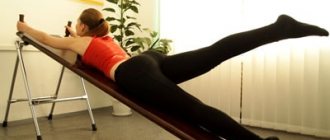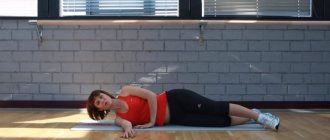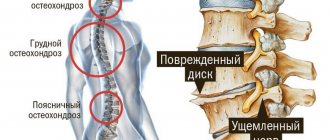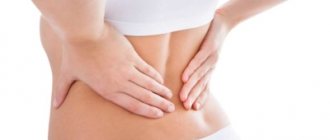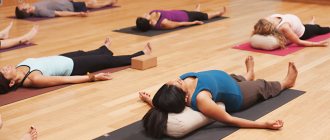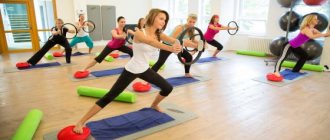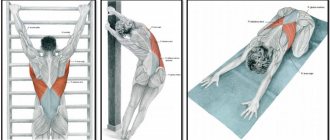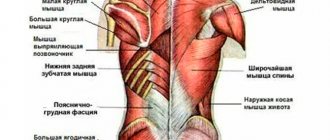A herniated spine is not a reason to give up and quit sports. Find tips to help you continue working out at the gym safely.
Training for spinal hernia in the gym
Intervertebral hernia is a very serious problem that imposes various restrictions not only in the choice of sport, but also in everyday life. Many people believe that with such a disease it is strictly forbidden to exercise in the gym.
In order to understand whether they are right or wrong, you need to understand what an intervertebral hernia is and what danger it poses.
What is an intervertebral hernia?
Intervertebral hernia is a disease of the musculoskeletal system, which is a violation of the integrity of the intervertebral disc. The intervertebral disc absorbs the movements of the vertebrae between which it is located.
The disc consists of a shell - the fibrous ring and its interior - the nucleus pulposus. When the annulus fibrosus is damaged, the contents of the disc begin to bulge outward, this is called a hernia.
Most often, this phenomenon occurs in the lumbar spine, less often in the cervical and thoracic spine.
Prohibited sports
Along with the fact that it is important to know what sports for a hernia are recommended by doctors, you should be well aware of the prohibited types of activity:
- Weightlifting – lifting dumbbells and barbells can cause serious harm to your back health.
- Intense running, aerobics, plyometrics.
- Heavy loads in the field while standing/sitting.
- Certain types of light gymnastics are recommended by a doctor.
PLEASE ATTENTION Even when performing permitted exercises, you should very carefully focus on your own sensations - sports with a moderate load should not cause pain, only slight fatigue is allowed, as after any intense workout.
General recommendations
Don't overload your back. Under no circumstances should you carry heavy bags over long distances, load cabinets, unload trucks with cement, etc. In this case, you cannot avoid back pain and aggravation of the problem situation.
Sit less. While sitting, the spine experiences enormous stress. If you have a sedentary job, get up from your chair from time to time to walk a little and do a light workout. This will relieve tension from the spine. In addition, warming up will help normalize blood circulation in the body.
If possible, eliminate running and jumping from your life. As you run, with each step, the weight of your body, multiplied by the acceleration of free fall, falls on your spine. When you jump, the load increases significantly.
Hernias and bodybuilding. How to exercise correctly and is it necessary?
My respect, ladies and gentlemen! It’s Friday on the calendar, which means it’s time for a note from our “Patient’s Corner” section, and today we’ll talk about the topic “Hernia and bodybuilding.”
After reading, you will learn everything about this acquired disease - how it forms, why, what effects it leaves on health, we will also figure out how to properly train for hernias, which exercises should be avoided and which ones to use.
So, take your seats in the auditorium, we are starting.
Hernia and bodybuilding: FAQ questions and answers
Well, I would like to start this note with a familiar statement to all of us: “do no harm.” Indeed, few people talk about the other side of the medal of strength training, but it is quite unpleasant. Often, instead of improving one’s health, when a person comes to the gym, he ruins it.
And okay, he’s ruining it himself, as they say, my health, I do what I want, but more and more often a third-party specially trained person takes part in the process, meaning a trainer.
It’s exactly this kind of letter: “help me, what should I do now” that I’ve started receiving lately in the project’s email.
Readers share their first unsuccessful experience of going to the gym and the appearance of sores that they did not have before. Sometimes a person decided to simply tone his muscles in order to become more fit and shapely, but in fact he developed a protrusion or herniation of a spinal disc. Those.
We came to the gym to improve our health, but we leave it with a serious (for life) illness, which affects the comfort of life. Of course, after such abuse of one’s health, a person loses all desire not only to go to the gym, he is jarred by the very word healthy lifestyle.
The first negative experience of training in the gym leaves an indelible mark on the life of a novice athlete and, moreover, can forever discourage him from various types of fitness centers and gyms to change himself.
With this series of notes, and we already have articles such as scoliosis and bodybuilding, arthrosis and bodybuilding and others, we will try to convey information about how to train if you already have any serious illness, and what measures are necessary to take to prevent it. In continuation of this post we will talk about hernias and bodybuilding.
Note: For better assimilation of the material, all further narration will be divided into subchapters.
Spine - instructions for use
When coming to the gym for the first time, the most common thing a beginner can hear is: “do the basics!” Without bothering to find out whether the athlete has any health problems, diseases or limitations, he is put on the base.
This is the wrong approach and can be harmful to the health of a beginner. Basic exercises are some of the most difficult to coordinate, and to work with them you need to have a pumped up “brain-muscle” channel, i.e.
so that all stages of the movement are performed synchronously, and the load is pulled by the proper muscle units.
Therefore, placing a newcomer (regardless of gender) on base is a sure way to ruin him. No one will look after your equipment for free, and you simply cannot know it yourself, because... The decision to go to the gym came spontaneously, and you didn’t spend months at home studying videos/books on exercise techniques.
When getting to the base, for example, squats with a barbell or deadlift, we expose our fragile spine to loads that are unusual for it, the slightest violation of technique and hello... “oh, something shot inside me.”
The spinal column consists of several sections formed by a corresponding group of vertebrae, each of which is responsible for a particular organ/part of the body and symptoms if it is incorrectly positioned or displaced.
When you initially come to the gym, you most likely already have spinal curvature, scoliosis or other forms of it, coupled with weak back muscles, in particular the erector spinae. There is a high probability of a back breakdown and a negative impact on the intervertebral discs. All this can result in the following spinal disorders.
The most common types of spinal disorders are changes in posture - kyphosis, lordosis, scoliosis.
Working with weights leads to compression of the intervertebral discs, irritation of the nerves and the occurrence of protrusions and hernias.
When working with basic exercises, the spine experiences colossal overloads, a minimum of 60 kg when working while standing and up to 730 kg when bending and lifting weights from the floor.
95% have them to one degree or another ), can result in an event called “I’ve done it, what should I do now?” "
Disc protrusion: what is it?
Sometimes doctors diagnose disc protrusion, and some equate these concepts: hernia = protrusion, this is not so. Protrusion is a type of hernia characterized by protrusion (prolapse) of the contents of the disc itself beyond the boundaries of the spinal column. Depending on the direction of the protrusion, the protrusion pinches the nerve roots of the spinal nerves or the spinal cord.
Prolapse (disc prolapse) can occur anywhere in the spinal column, from the neck (cervical spine) to the lower back (lumbar spine).
Pain that extends below the knee (called sciatic nerve inflammation) occurs when the intervertebral disc presses on a nerve in the lumbar spine.
This may manifest as numbness/pin-pricks in the leg area and difficulty pushing off the leg.
A combination of pain in the lower back, buttocks, groin or leg can occur either from irritation in the disc itself, or when the disc causes irritation to nearby nerves.
Neck pain, headaches, and shoulder/arm pain can also be created by a bulging disc that presses on the nerves in the neck.
The symptoms are similar: numbness in the extremities of the arms, parts of the face and weakness when performing shoulder, elbow and hand movements.
Disc herniation: what is it?
Degenerative changes in the structure of the disc, leading to the destruction of the fibrous ring and leakage of the inner (pulpous) nucleus through the outer part of the disc.
Symptoms of a hernia are:
- leg/back pain;
- numbness/tingling in the leg;
- muscle weakness in the legs;
- loss of reflexes in the legs;
- pain in the lower back/buttocks.
Medical statistics tell us that the highest frequency of localization of intervertebral disc herniations occurs in the following parts of the spine (vertebral numbers):
- vertebrae L 5 -S 1 – 36% ;
- L 4 -L 5 – 31% ;
- L 4 -L 5 , L 5 -S 1 – 21% ;
- on several levels - 6%.
When a person has a herniated disc, it has a negative impact on the spinal cord and the spinal nerves that run along the entire spine. The nerves pass through the small gap between the vertebrae and the discs, so if there is a herniated disc, it puts pressure on this passage, compressing the nerves.
The mechanism of hernia occurrence is clearly reflected in the following image:
Stages of hernia development
Hernias can appear suddenly or develop over several weeks/months. In total, there are 4 stages of changes in intervertebral discs:
- degenerative changes – chemical changes associated with disc aging and weakening;
- protrusion/prolapse – protrusion of the disc (change in its original position) with a slight impact on the spinal canal and/or spinal nerves;
- extrusion/hernia - rupture of the annulus fibrosus and movement within the disc of the gel-like nucleus;
- disc sequestration/absorption – the nucleus pulposus breaks through the fibrous ring and extends beyond the intervertebral disc.
A fairly common type of hernia is...
Schmorl's hernia: what is it?
This is a change in the intervertebral disc in the form of a breakthrough of its cartilage tissue into the vertebral body. The hernia is named after the German pathologist Schmorl, who was the first to diagnose this unusual type of hernia. It is most often detected through MRI, but can also be seen through X-rays.
It occurs for various reasons and at different ages, the main factors of its occurrence include:
- wear and tear on the spine over time;
- lack of vitamin D in the body;
- lifting iron/lifting heavy weights at a young age, before the vertebrae “ossify”;
- hereditary factor;
- immobility of a person (for example, lying in a cast for a long time).
The main difference between Schmorl's hernia and intervertebral hernia is the mechanism of origin. In the second case, there is a gradual displacement of the nucleus pulposus and rupture of the fibrous ring; in the first case, the cartilaginous tissue of the disc is pressed into the vertebral body, which does not in any way affect the person’s performance, because does not have a negative effect on nerve endings (does not pinch them).
Schmorl's hernia tends to increase significantly in size, and over time can lead to the formation of an intervertebral hernia.
Actually, with a theoretically frightening


